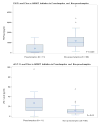High viral load and elevated angiogenic markers associated with increased risk of preeclampsia among women initiating highly active antiretroviral therapy in pregnancy in the Mma Bana study, Botswana
- PMID: 23344545
- PMCID: PMC3683097
- DOI: 10.1097/QAI.0b013e318286d77e
High viral load and elevated angiogenic markers associated with increased risk of preeclampsia among women initiating highly active antiretroviral therapy in pregnancy in the Mma Bana study, Botswana
Abstract
Background: Risk factors associated with preeclampsia in HIV-infected women remain largely unknown. Systemic angiogenic imbalance contributes to preeclampsia in HIV-uninfected women, but changes in angiogenic markers after highly active antiretroviral therapy (HAART) initiation have not been studied.
Methods: The Mma Bana study randomized 560 HIV-infected, HAART-naive pregnant women with CD4 counts ≥ 200 cells per cubic millimeter between 26 and 34 weeks gestation to lopinavir/ritonavir/zidovudine/lamivudine or abacavir/zidovudine/lamivudine. Another 170 participants with CD4 counts less than 200 cells per cubic millimeter initiated nevirapine/zidovudine/lamivudine between 18 and 34 weeks gestation. Characteristics of 11 women who developed preeclampsia were compared with the remaining 722 Mma Bana participants who delivered using logistic regression. Plasma samples drawn at HAART initiation and 1 month later from 60 women without preeclampsia and at HAART initiation for all 11 preeclamptic women were assayed for placental growth factor (PlGF) and soluble FMS toll-like tyrosine kinase-1 (sFlt-1).
Results: Pre-HAART viral load greater than 100,000 copies per milliliter was associated with preeclampsia (odds ratio: 5.8, 95% confidence interval: 1.8 to 19.4, P = 0.004). Median pre-HAART PlGF level was lower and sFlt-1 was higher in women who developed preeclampsia vs those who did not (130 vs 992 pg/mL, P = 0.001; 17.5 vs 9.4 pg/mL, P = 0.03, respectively). In multivariate analysis, PlGF and viral load remained significantly associated with preeclampsia. No significant changes in angiogenic factors were noted after 1 month of HAART treatment among non-preeclamptic women.
Conclusions: Pre-HAART viral load greater than 100,000 copies per milliliter and PlGF predicted preeclampsia among women starting HAART in pregnancy. Among non-preeclamptic women, HAART treatment did not significantly alter levels of PlGF or sFlt-1 after 1 month of treatment.
Conflict of interest statement
MH has served as a paid DSMB member for Beohringer Ingelheim, Pfizer, Tibotec and Medicines Development.
Similar articles
-
Serum levels of vasoactive factors in HIV-infected pre-eclamptic women on HAART.J Obstet Gynaecol. 2021 May;41(4):546-551. doi: 10.1080/01443615.2020.1755626. Epub 2020 Jun 9. J Obstet Gynaecol. 2021. PMID: 32515639
-
Therapeutic levels of lopinavir in late pregnancy and abacavir passage into breast milk in the Mma Bana Study, Botswana.Antivir Ther. 2013;18(4):585-90. doi: 10.3851/IMP2474. Epub 2012 Nov 26. Antivir Ther. 2013. PMID: 23183881 Free PMC article. Clinical Trial.
-
Circulating angiogenic factors and the risk of preeclampsia.N Engl J Med. 2004 Feb 12;350(7):672-83. doi: 10.1056/NEJMoa031884. Epub 2004 Feb 5. N Engl J Med. 2004. PMID: 14764923
-
A Review of Angiogenic Imbalance in HIV-Infected Hypertensive Disorders of Pregnancy.Curr Hypertens Rep. 2019 Jul 24;21(9):69. doi: 10.1007/s11906-019-0970-7. Curr Hypertens Rep. 2019. PMID: 31342170 Review.
-
First and Second Trimester Serum sFlt-1/PlGF Ratio and Subsequent Preeclampsia: A Systematic Review.J Obstet Gynaecol Can. 2018 May;40(5):618-626. doi: 10.1016/j.jogc.2017.07.014. Epub 2017 Sep 15. J Obstet Gynaecol Can. 2018. PMID: 28927814
Cited by
-
Angiogenesis, Lymphangiogenesis, and the Immune Response in South African Preeclamptic Women Receiving HAART.Int J Mol Sci. 2019 Jul 30;20(15):3728. doi: 10.3390/ijms20153728. Int J Mol Sci. 2019. PMID: 31366152 Free PMC article. Review.
-
A Narrative Review of the Renin-Angiotensin-Aldosterone System in the Placenta and Placental Bed of HIV Infected Women of African Ancestry with Preeclampsia.Curr Hypertens Rep. 2021 Aug 20;23(8):39. doi: 10.1007/s11906-021-01158-1. Curr Hypertens Rep. 2021. PMID: 34415457 Free PMC article. Review.
-
Combined antiretroviral therapy for HIV and the risk of hypertensive disorders of pregnancy: A systematic review.Pregnancy Hypertens. 2019 Jul;17:178-190. doi: 10.1016/j.preghy.2019.05.015. Epub 2019 May 17. Pregnancy Hypertens. 2019. PMID: 31487638 Free PMC article.
-
Eliminating preventable HIV-related maternal mortality in sub-Saharan Africa: what do we need to know?J Acquir Immune Defic Syndr. 2014 Dec 1;67 Suppl 4(Suppl 4):S250-8. doi: 10.1097/QAI.0000000000000377. J Acquir Immune Defic Syndr. 2014. PMID: 25436825 Free PMC article. Review.
-
HIV Associated Preeclampsia: A Multifactorial Appraisal.Int J Mol Sci. 2021 Aug 25;22(17):9157. doi: 10.3390/ijms22179157. Int J Mol Sci. 2021. PMID: 34502066 Free PMC article. Review.
References
-
- Dolea C, AbouZahr C. Global burden of hypertensive disorders of pregnancy in the year 2000: Evidence and Information for Policy (EIP) World Health Organization; Geneva: Jul, 2003. [Accessed 8-Oct-11]. http://www.who.int/healthinfo/statistics/bod_hypertensivedisordersofpreg....
-
- Villar J, Say L, Shennan A, et al. Methodological and technical issues related to the diagnosis, screening, prevention, and treatment of preeclampsia and eclampsia. International Journal of Gynecology and Obstetrics. 2004;85(Suppl 1):S28–S41. - PubMed
-
- Conde-Agudelo A, Villar J, Lindheimer M. Maternal infection and risk of preeclampsia: Systematic review and metaanalysis. American Journal of Obstetrics & Gynecology. 2008;198(1):7–22. - PubMed
-
- Firoz T, Sanghvi H, Merialdi M, et al. Preeclampsia in low and middle income countries. Best Practices and Research Clinical Obstetrics and Gynaecology. 2011;25:537–548. - PubMed
-
- Khan KS, Wojdyla D, Say L, et al. WHO analysis of causes of maternal death: a systemic review. Lancet. 2006;367:1066–74. - PubMed
Publication types
MeSH terms
Substances
Grants and funding
LinkOut - more resources
Full Text Sources
Other Literature Sources
Medical
Research Materials
Miscellaneous


